This is a take on the classic Italian bread with a hint of citrus and crowned with pastry cream. We call it Easter Ring, and it's a must for this holiday. The simple flavors are also perfect for a Spring brunch or with a cup of coffee. The sweet dough is easy to work with and can be made into individual breads with dyed eggs.
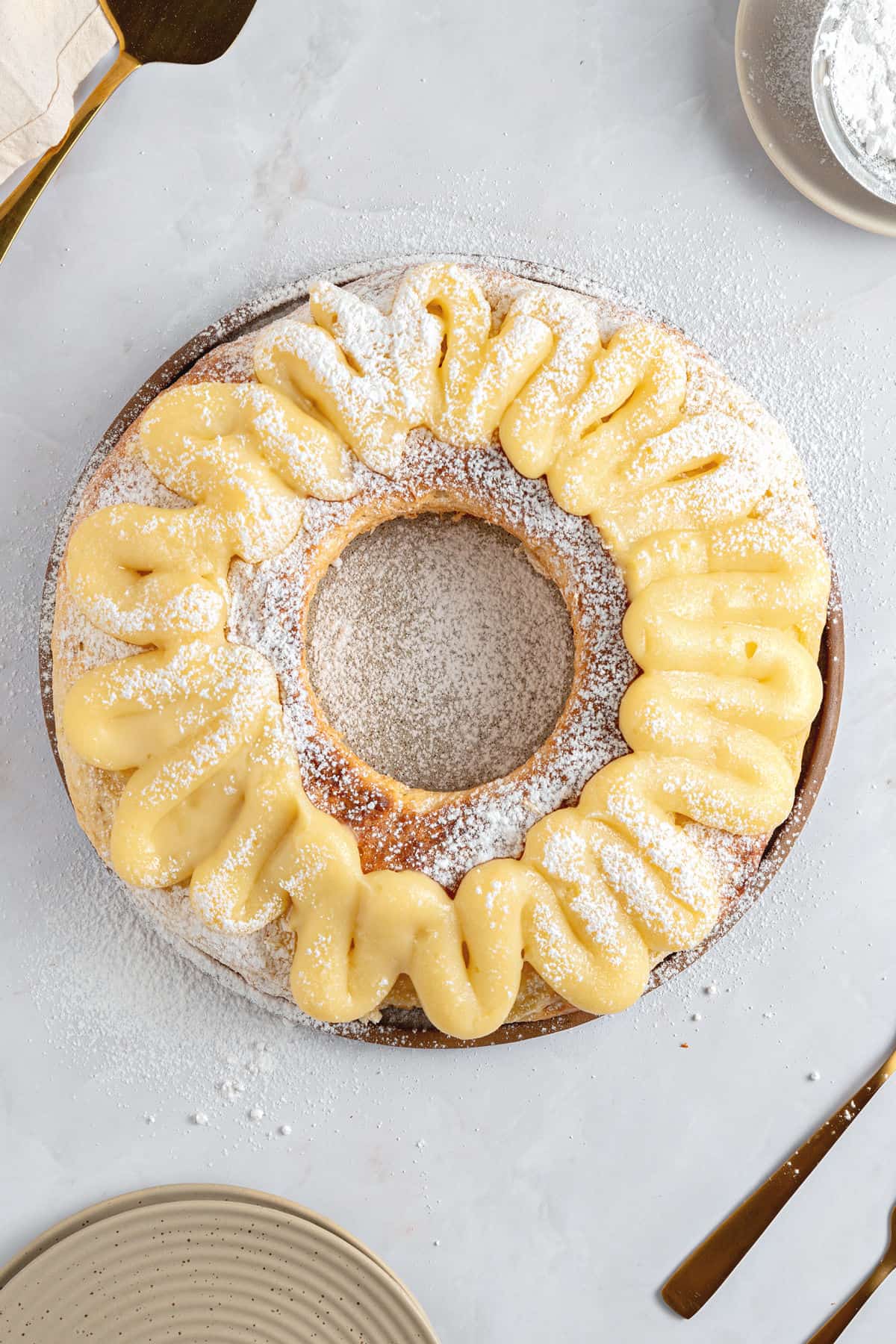
Holiday bread
Easter breads differ slightly depending on the country and traditions, and this is the one we eat here in Argentina, where we have an immense Italian heritage and yet manage to make many recipes our own. It's called Rosca de Pascua, which literally translates into Easter Ring.
We top the classic Italian bread with a vanilla pastry cream that's firm enough to stand proudly on its own but is also soft and creamy, creating a wonderful contrast with the dense crumb.
The dough resembles the Finnish Pulla and the glazed Easter braid, but they're all cousins. Sweet holiday breads don't differ much.
This bread dough has eggs and butter, so it's flavorful with a soft but rustic texture. It could qualify as a poor man's brioche but simpler to make and easier to work with.
I use lemon and vanilla as flavorings, which are traditional, and crown it with a thick layer of custard. It's truly memorable.
Watch our step-by-step videos
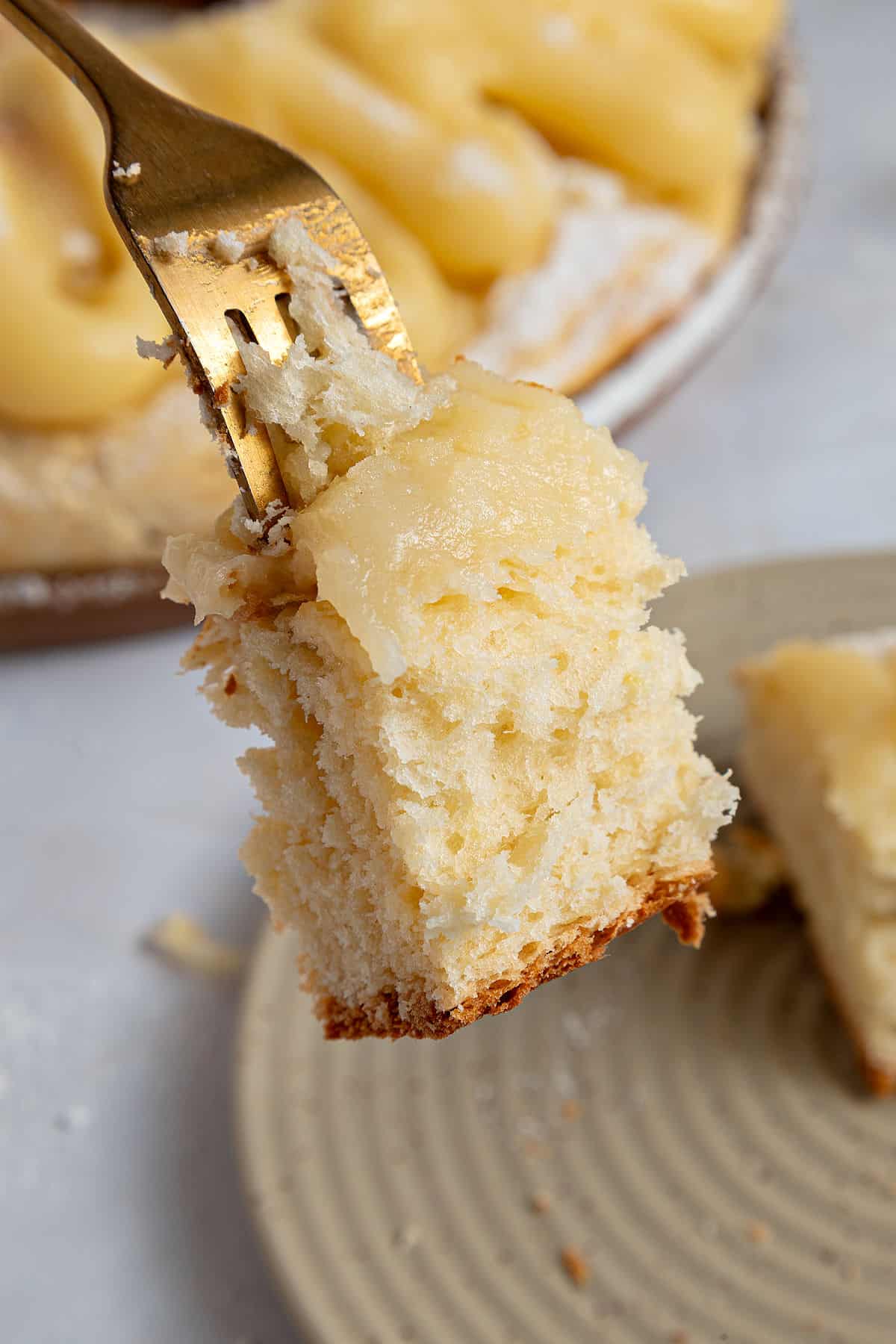
Types of yeast
Don't be afraid to work with yeast. It takes a little practice (what doesn't?), but the results are excellent! Making your own bread is a one-way journey for many people, including me.
- Dry yeast: You can buy instant or active dry, which look the same (image below) but are activated differently. The former goes directly into the dry ingredients (flour mostly), and the latter needs a wet environment (water in most cases) to foam and be ready. You can buy active dry yeast and instant yeast online.
- Fresh yeast: It comes in cubes usually and is crumbly and humid. This type has a much shorter refrigerator life than the dry versions, so it's not as popular. You can buy fresh yeast online.
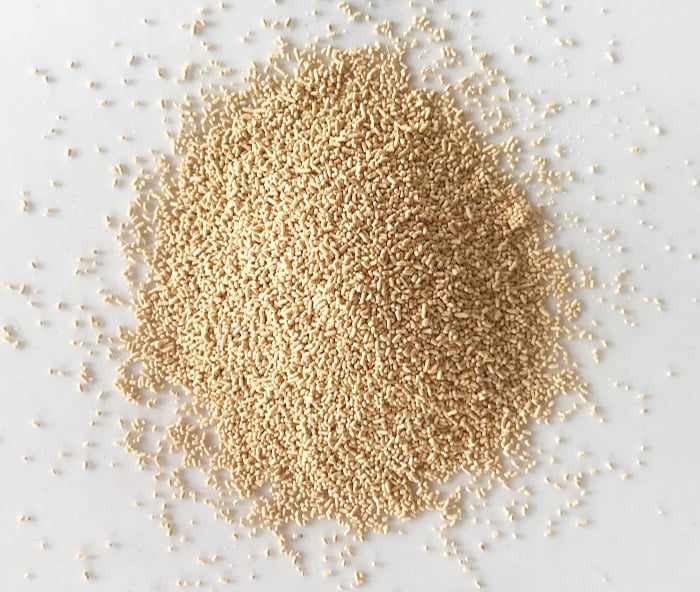
How to Make Sure Yeast Works
- Check expiration date: Replace if expired.
- Visual check: Should be beige to light brown and granular/powdery. Avoid if grayish, clumpy, or discolored.
- Smell test: Should have a mild, slightly sweet smell. Strong or unpleasant odors indicate it's bad.
Proofing test: Mix ½ teaspoon sugar in ¼ cup warm water (comfortable to touch). Sprinkle ½ teaspoon of dry yeast on top and stir gently. Wait 5-10 minutes until you start to see some activity. Fresh yeast will foam and bubble more; instant bubbles less than active dry yeast.
Golden Rule: When in doubt, buy new! It's better to be safe than to have your baked goods fall flat and be inedible.
Make the sweet dough
Most bread recipes can be made either in a stand mixer with the dough hook (like the Kitchen Aid stand mixer or similar) or by hand.
Of course, the former is easier, but sometimes we don't have access to one, so knowing how to bake the old-fashioned way (hands in the dough!) is useful.
Stand mixer
Proof the yeast, that is, check if it's good to use directly in the mixer bowl.
Start adding the rest of the ingredients to the yeast mixture in the order given.
Knead using the dough hook attachment until you have a sticky dough. The dough will stick heavily to the sides of the bowl but eventually will start to gather into a mass around the hook and will eventually clear the sides and bottom of the bowl after it's kneaded more. Don't be tempted to add too much extra flour! This dough is supple and not really sticky, but it might feel that way slightly, especially before the initial rest, as it will become less sticky after it relaxes.
By hand
The first two steps are the same as above, but you mix everything in a large bowl. Use a wooden spoon or spatula. Or your clean hands though it's messy.
There comes a moment when the dough is still wet, but it's hard to stir in more flour. It looks like a very thick, lumpy pancake batter. At this point, you transfer it to a heavily floured board and get your hands into action. Use flour from the amount given in the recipe. We don't want to incorporate extra flour unless needed.
At first, the dough will be very sticky. This is a wet dough enriched with eggs and butter, so the way to 'knead' it is by lifting it and letting it fall, trying to fold it onto itself when you do that. It will get less sticky as you continue to do that. Knead it for about 7-8 minutes first, and add more flour, a tablespoon at a time, when necessary.
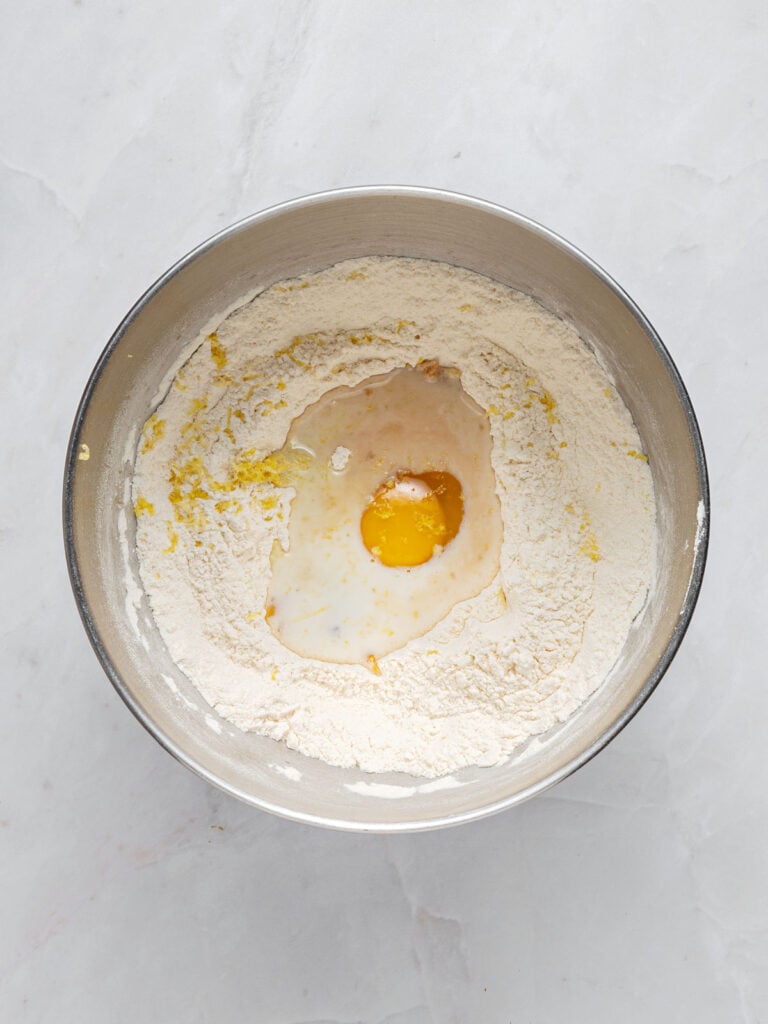
Wet ingredients
Add them to the dry ingredients except for the salt, which is added after you knead them a little to avoid mixing it with the yeast from the beginning.

Butter pieces
Make sure they're at room temperature, soft but not greasy, and add them in 3 or 4 parts, leaving about 30 seconds in between each. This helps integrate the butter better than if you add just one large piece.
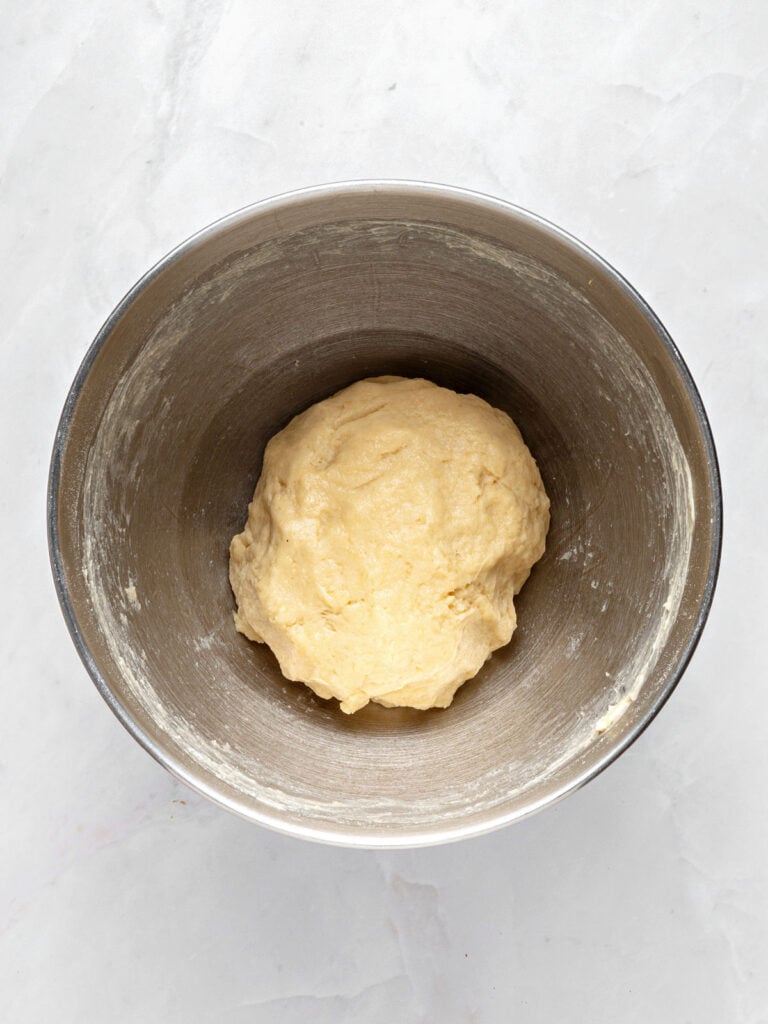
Let it rest
It's not a full rise, it just needs to rest for about 15 minutes to relax. You can leave it in the mixer bowl or on the counter if you knead it by hand.
Always cover it with a clean towel to prevent dryness.
Make the ring
We're making a circle or dough ring, so it's super easy! As you would a very large bagel. You can make it two ways:
- Make a long rope and pinch the ends together to make a ring. The thing is that it will be irregular, and there was no way to hide the place where the ends meet.
- Start with the dough ball, flatten the center and make a hole with your hand, like a bagel. This way is much better in my opinion and delivers a more even-shaped bread after it's baked. So it's the one I recommend.
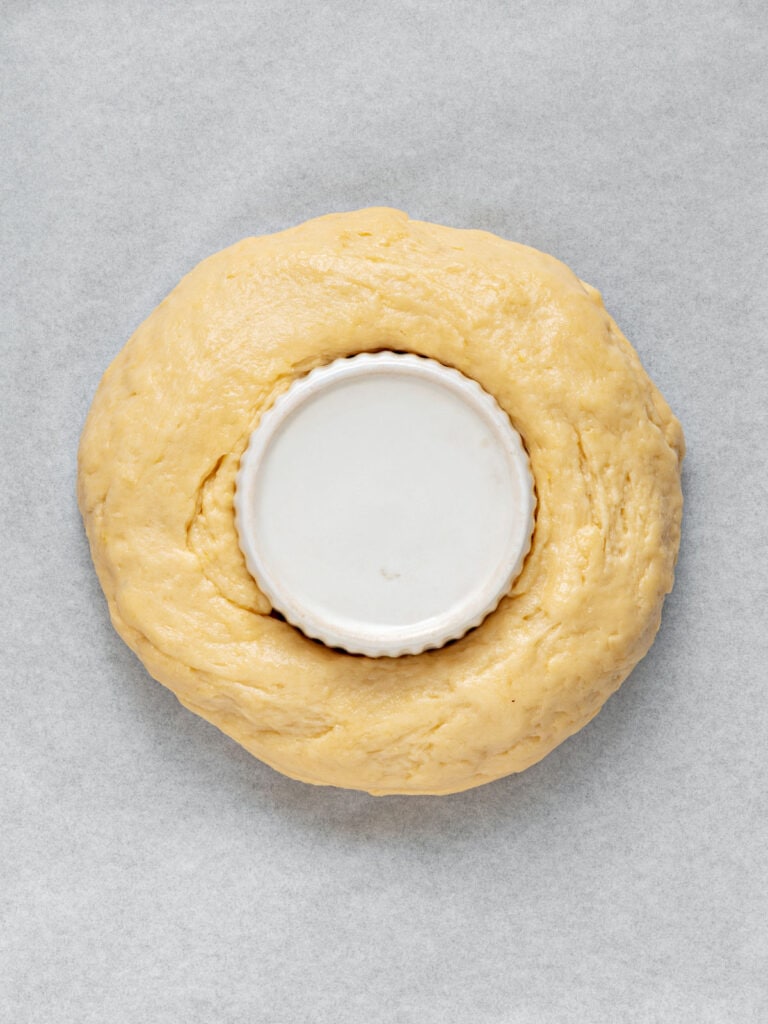
Center hole
It should accommodate a small ramekin or bowl (place it upside down) or a round cookie cutter.
Important
The rameking or cutter you use for the center hole will go into the oven and bake with the bread, so make sure it's heatproof! Use metal, ceramic or glass. Don't use plastic!
Let it rise
The ring needs to rise until almost doubled, though it might not always grow that much. It will take 1 to 1 ½ hours.
The dough will be lighter to the touch and less sticky.

Egg wash
I use egg and milk to brush the bread before baking it for a shinier and deeper golden color, but you can use only milk; most of it will be covered with pastry cream anyway.
Vintage Kitchen Tip
If the dough hardly rises during the first half-hour, it's probably because the room is too cold. Wrap the bowl with a blanket, a thick towel, or a sweater. You need to create a warmer environment for the yeast to do its work.
Pastry cream
What is baker's pastry cream, as we call it here? It's basically a much thicker vanilla cream that holds its shape when piped on top of the bread. It doesn't slide or drip.
The method is the same as with a regular pastry cream, but we add more thickening ingredients (cornstarch and flour) to make it firmer.
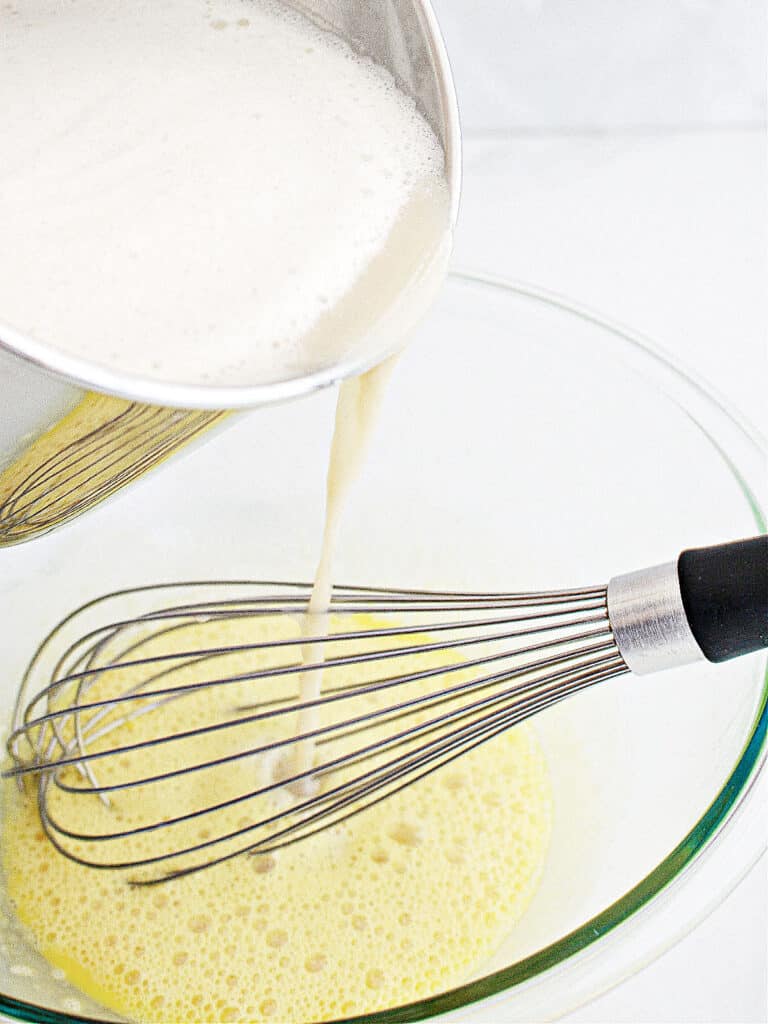
Hot milk
I use egg and milk to brush the bread before baking it for a shinier and deeper golden color, but you can use only milk; most of it will be covered with pastry cream anyway.
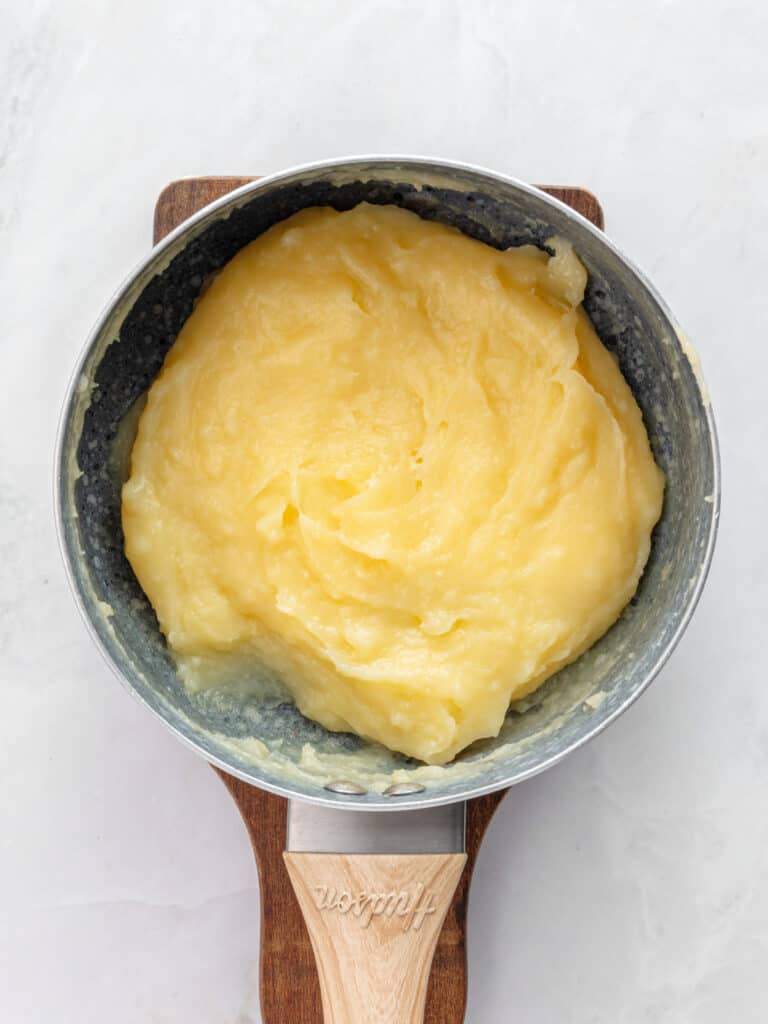
Egg wash
I use egg and milk to brush the bread before baking it for a shinier and deeper golden color, but you can use only milk; most of it will be covered with pastry cream anyway.
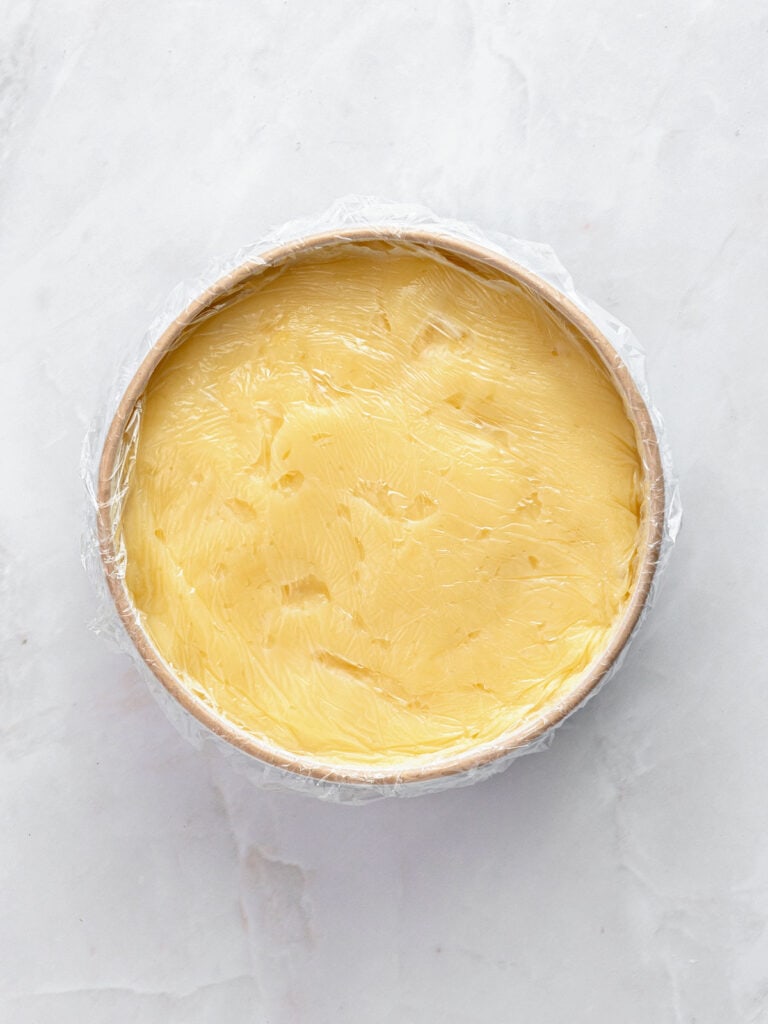
Cover it
Use plastic wrap to cover it, making sure it touches the whole surface. This prevents a thick layer from forming as it cools.
Refrigerate it before transferring it to the piping bag; you need to beat or whisk it to smooth it again before using it.
Can it only be piped?
No! You can use a spoon or spatula to spread a thick layer on top of the bread. It will be irregular and more rustic but just as gorgeous.
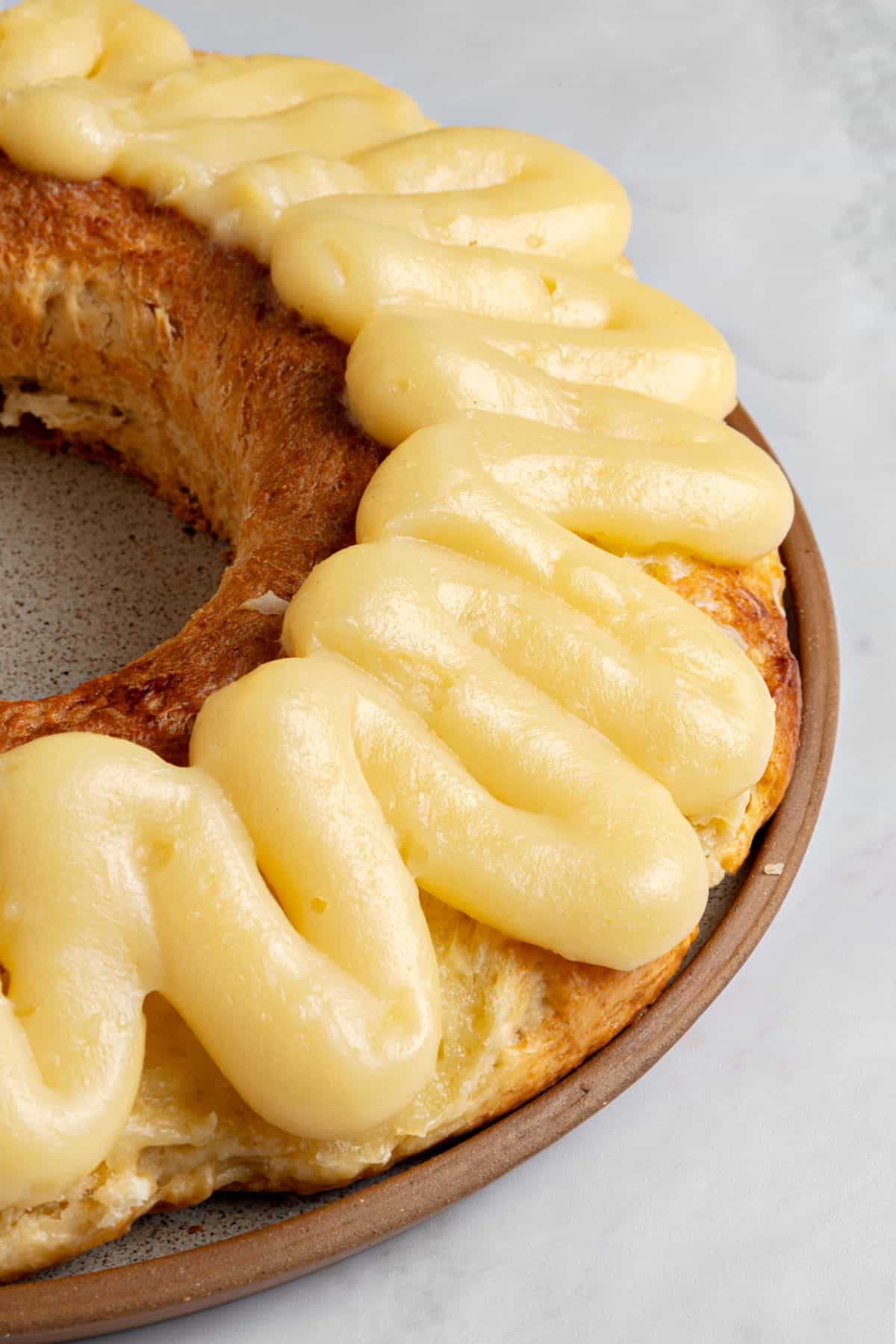
Kitchen Notes
- Organization: Read the recipe first and ensure you have the ingredients at the correct temperature, the utensils and equipment needed, and enough workspace. This will make the process so much easier.
- Baking time: consider that all ovens and pans are different, even if they look similar. The baking time in my recipes is as accurate as possible, but it might take you more or less time. You can use a thermometer (like the OXO oven thermometer) to check that your oven is at the right temperature. I recommend tracking how your oven works and what tiny details you might need to adjust.
- Make sure the yeast is not expired. Old or moldy yeast is no good, similar to baking powder. If not kept in the right conditions they will not work properly. In short, your bread will not rise. All your effort will be wasted. So, buy yeast according to the amount of bread you bake. Keep it in the refrigerator, well covered, so it's not in contact with air.
- Don't mix yeast with salt at the beginning of the recipe. They should be added separately and mixed after the yeast is combined with some liquid and flour. They are not friends, as salt reduces some of the yeast's power and you certainly don't want that for your bread.
- Leftovers: They make excellent French toast the next day or for Easter brunch or breakfast. You can also make bread pudding with apples or other fruit that pair well with pastry cream.
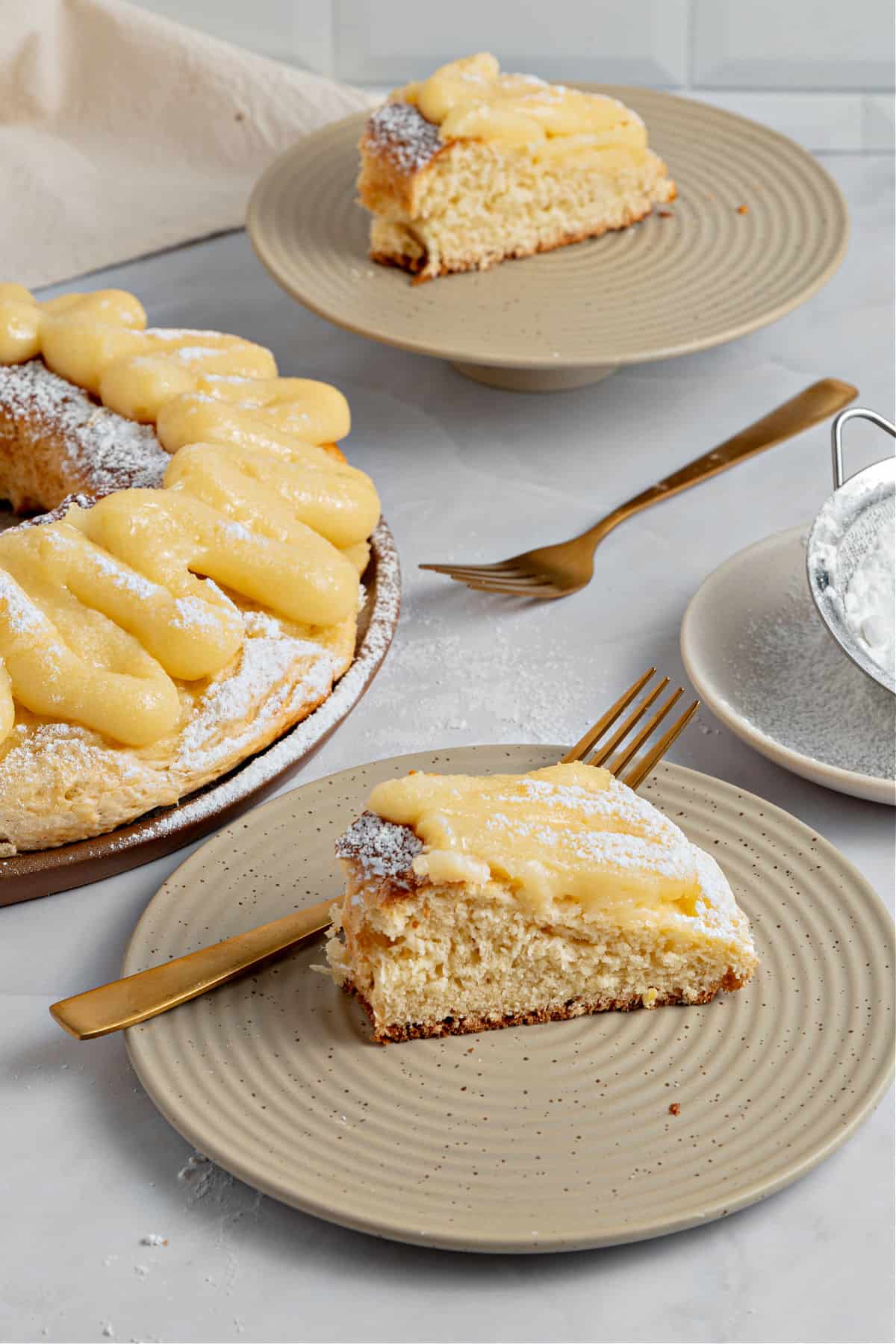
More Easter recipes:
Before you go
If you made this recipe and loved it, you can comment below and leave a five-star ⭐️ review. Also, if you had issues, let me know so we can troubleshoot together.
You can also subscribe to our FREE email series 'Baking the Best' and our regular newsletter. Or follow and save my recipes on Pinterest.
As an Amazon Associate, I earn from qualifying purchases. Read my disclosure policy.
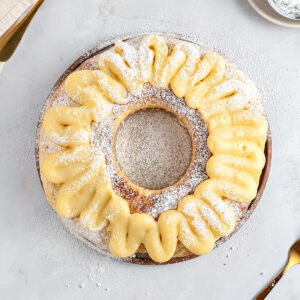
Easter Bread Ring with Pastry Cream
Ingredients
For the sweet dough:
- 2 cups all-purpose flour, estimated, you might need a little more
- ¼ cup sugar
- ¼ cup whole milk, at room temperature
- 1 ½ teaspoons active-dry or instant yeast, or 4 ½ teaspoons fresh yeast
- 1 egg, at room temperature
- ½ tablespoon liquid honey
- ½ teaspoon vanilla extract
- ½ teaspoon lemon zest, loosely packed
- ½ teaspoon salt
- ¼ cup unsalted butter, at room temperature
For the baker's pastry cream:
- 1 ⅓ cups whole milk
- ⅔ cup sugar
- ¼ cup cornstarch
- 3 tablespoons all-purpose flour
- 2 eggs, at room temperature
- 1 teaspoon vanilla extract
For the egg wash:
- 1 egg, at room temperature
- 1 tablespoon milk
To finish:
- 1 or 2 teaspoons powdered sugar
Instructions
Sweet bread dough:
- If using fresh or active-dry yeast, place half cup of flour with a tablespoon of sugar (both subtracted from the total amount), half the milk and the yeast in the bowl of a stand mixer (KitchenAid or similar). Mix a little and let stand 5-10 minutes, until bubbles start to appear. If it has no activity, the yeast is probably old. Buy new and start again.
- Add the rest of the flour and sugar to the bowl with the yeast mixture. If using instant yeast, place 2 cups all-purpose flour and ¼ cup sugar in the bowl and add the yeast. Stir to mix.
- Incorporate 1 egg, ¼ cup whole milk, ½ tablespoon liquid honey, ½ teaspoon vanilla extract and ½ teaspoon lemon zest. Start kneading and sprinkle in ½ teaspoon salt. Knead for 2 or 3 minutes, until all the ingredients start to combine.
- Add ¼ cup unsalted butter in three or four parts, waiting about 20-30 seconds between each addition. Continue kneading until a smooth and soft dough is formed, about 8 to 10 minutes. It is very elastic and hardly sticks to the fingers.
- Form a ball, cover with a clean kitchen towel, and let it rest for 15 minutes. I do so on the kitchen counter, but you can use a bowl.
- Have ready a lightly buttered or parchment-lined baking sheet.
- Once the dough has relaxed, form a log with it and then a ring, sinking the center with your hand and opening it (as you would a bagel), until you can place an upside-down small glass or ramekin or a scone ring in the center to keep the circle open. Make sure they’re oven-safe, metal or ceramic, as it will go with the dough into the oven.
- Place the ring on the prepared baking sheet with the glass or ring in the center. cover, and let the dough rise in a warm place for approximately 1 hour.
Thick pastry cream:
- In a medium saucepan, bring 1 ⅓ cups whole milk to a boil with ⅓ cup of the sugar.
- In another bowl, whisk the remaining ⅓ cup sugar with ¼ cup cornstarch, 3 tablespoons all-purpose flour and 2 eggs until it’s combined.
- Pour the hot milk little by little (to avoid cooking the eggs) over the egg mixture, mixing constantly, and return the entire mixture to the same saucepan and place over medium-low heat. Whisk constantly until it boils again. Continue cooking for about 1 minute, whisking constantly, or until it thickens and is very smooth. The amount of time depends on how hot the stove is. Don’t let it scorch or burn.
- Remove from the heat, add 1 teaspoon vanilla extract and stir well. If it has lumps, pass it through a sieve. Transfer to a not-too-deep, rather shallow bowl, cover with plastic wrap touching the entire surface to avoid dryness, and refrigerate while the dough finishes rising.
To assemble and bake:
- Preheat the oven to 350°F (180°C).
- When the dough has risen and is ready to bake, mix 1 egg and 1 tablespoon milk for the egg wash in a small bowl and carefully brush the ring with it.
- Bake in the preheated oven for approximately about 25 minutes, until golden brown and it sounds hollow if lightly tapped on the bottom.
- Let it cool on a wire rack.
- Transfer the pastry cream to a piping bag with a plain tip. Make a zigzag pattern on the surface, not too far apart, covering it well with pastry cream. I do this while the bread is still warm, but be careful not to deflate it. You can wait longer if needed.
- Sprinkle with 1 or 2 teaspoons powdered sugar (not too much, so the cream is visible).

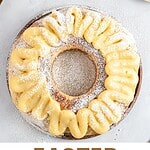
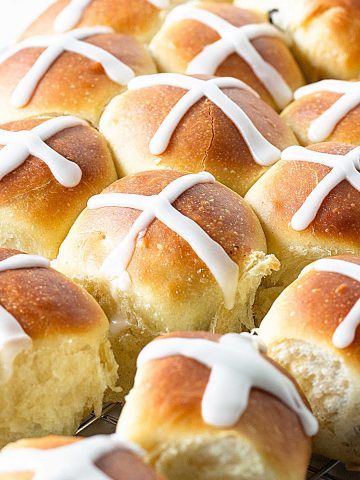
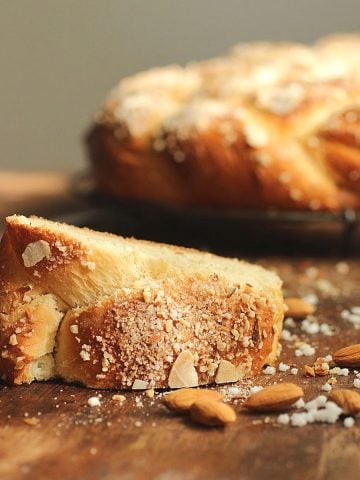
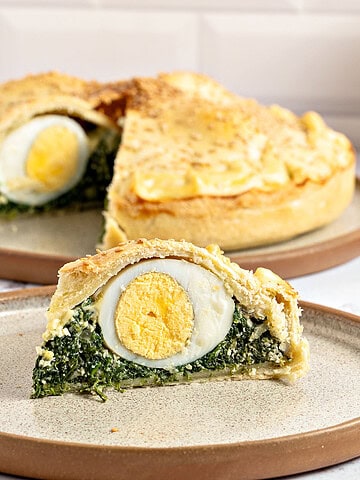
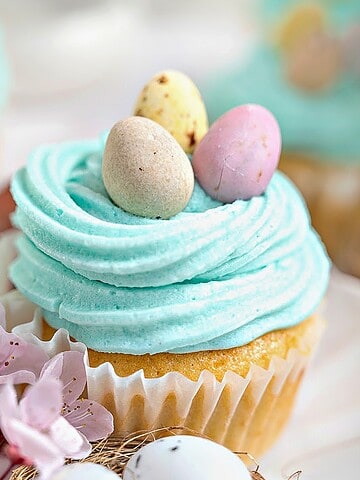
Rate and review this recipe